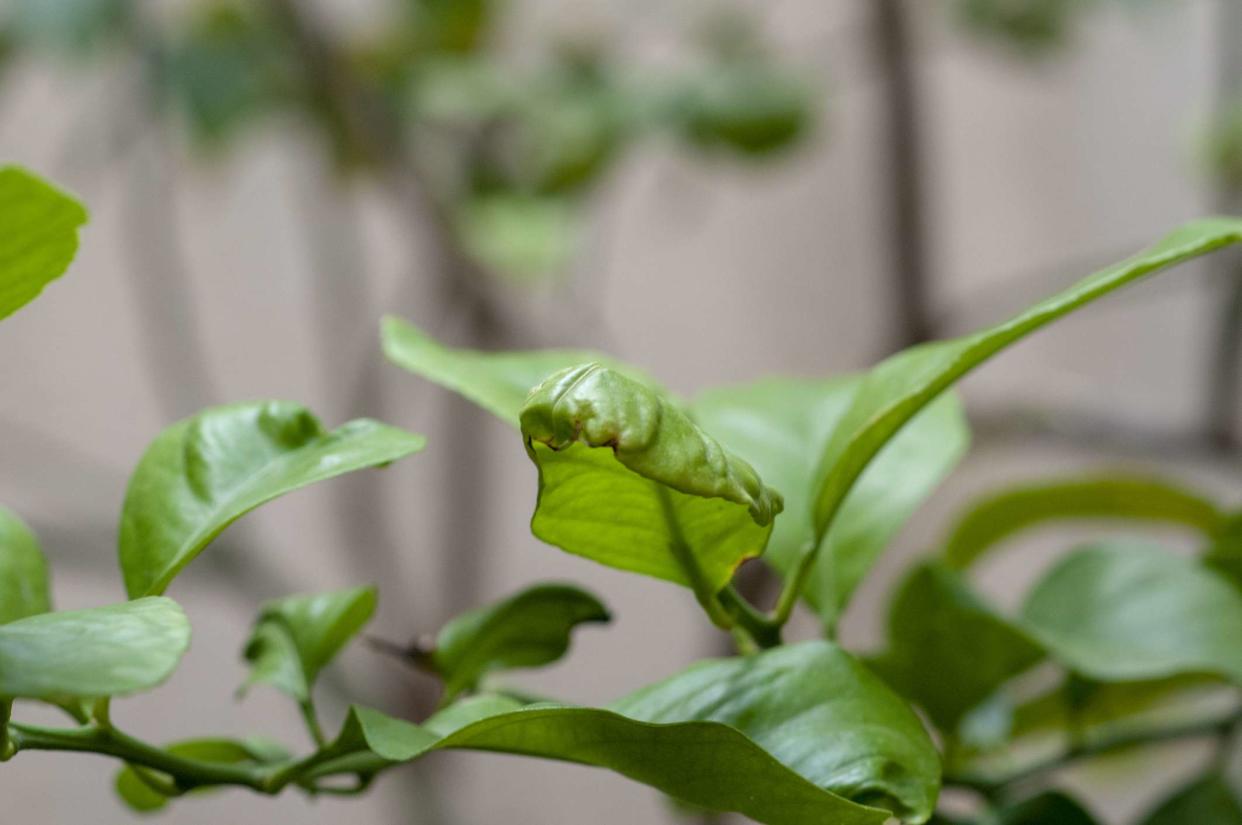7 Reasons Why Your Lemon Tree's Leaves Are Curling

PhotoStock-Israel / Getty Images
If you have a lemon tree, either in a pot or in your yard, you may have noticed at some point that its leaves are curling. It's not uncommon, but it is an early sign the tree is distressed. Curling lemon tree leaves are caused by environmental factors, maintenance errors, insect pests and diseases.
Here's what you need to know to identify curling leaves and remedy the underlying cause to keep your lemon tree in vigorous good health.
7 Common Causes of Lemon Tree Leaf Curling
At the first sign of curling leaves on a lemon tree, check for soil moisture. If hydration is adequate you may have an insect problem or nutrient deficiency. Take steps early to correct the problem before it impacts roots. Once roots are affected, it's more difficult to restore the tree to good health.
Drought Stress
Insufficient watering is the most common cause of edges or tips of leaves curling toward the middle. Lemons trees require a good amount of water and thrive better with deep watering once or twice a week. Potted plants need to be watered more often.
To check an in-ground tree for drought stress, use a moisture meter or insert a garden trowel into soil at the dripline. If the trowel comes out clean and dry, water deeply.
Check for soil moisture in your potted lemon tree with your finger or a moisture meter. If soil is dry more than 2 inches below the surface, give the tree a good soaking until water runs through the pot's drainage holes. Avoid using clay pots which leach moisture from soil.
Temperature Extremes
Lemon trees are hardy in USDA zones 8 through 11. Northern parts of this range can experience frost and freezing while southern regions see temperatures rise above ideal levels of 70 to 100 degrees F. Prevention is the best protection against temperature extremes.
Frost damage happens when temperatures drop below 29 degrees F. When low temperatures are forecast, give in-ground trees a thorough watering to protect roots from moisture loss. Other options include covering the tree with a frost blanket or tarp. Bring potted plants indoors once temperatures drop to a consistent 40 degrees F.
To prevent damage from extreme heat, add a 2- to 3-inch layer of mulch around your tree. Remember to keep it from contacting the bark, which can lead to insect and disease problems. Move potted plants out of direct sunlight and keep soil moist.
Poor Air Circulation
Inadequate oxygen can cause leaf curl in overgrown trees with dense branching and foliage or planted too close to other trees.
This problem is more endemic to trees grown outdoors; however, pruning is just as important for potted trees. Increase air circulation for indoor plants with ceiling fans or place one to increase air flow around the tree, not directly onto it.
Nutrient Deficiencies
When leaves curl under the tree could lack sufficient nutrition. Lemon trees need specific amounts of primary nutrients as well as micronutrients, especially calcium, iron and magnesium.
Apply a quality citrus fertilizer for trees grown in-ground in late winter, early summer, and early autumn. Use citrus potting mix for potted trees and add a slow release granular citrus fertilizer at the beginning of the growing season. Or feed your tree every two to three weeks with an organic liquid product such a fish emulsion or liquid kelp.
Overfertilization also causes leaf curl so check the tree following a feeding and adjust the amount or frequency if symptoms develop.
Incorrect Watering
Leaf tips that curl under also indicate overwatering. Foliage turns yellow and drops.
In-ground trees need 1 to 2 inches of water twice weekly and more often during hot, dry weather. Water thoroughly to soak soil to a depth of 2 to 3 feet. Water potted plants every day or two to keep soil evenly moist. This is especially important for trees moved outdoors during summer months. Water less frequently during winter.
If ground is saturated, simply withhold water until excess drains. Avoid planting trees in low spots or at the base of an incline where rainwater accumulates. Don't let your potted tree sit in standing water. If the potting medium is extremely soggy, repot in fresh, dry material. Allow the roots to dry out for several days before resuming a normal watering schedule.
Pests
When leaves take on a cupped look inspect your tree for insect infestation. Aphids cause curling and cupping especially on new growth and leave behind a sticky substance call honeydew. The Asian Citrus psyllid leaves a white, waxy filament on distorted leaves.
Treat with a strong of water or apply a mild soap solution in cases of infestation. Use similar treatment for psyllids or spray with insecticide.
Spider mites, mealybugs, and scale are particular problems for potted plants grown indoors. In addition to these pests, whiteflies and leafminers can damage leaves on your outdoor tree.
Treat both indoor and outdoor lemon trees with neem oil or another horticultural oil.
Diseases
Lemon trees are vulnerable to several fungal and bacterial diseases that cause leaf curl.
Anthracnose is a fungal disease prevalent in extended periods of wet weather and often affects trees with old, dead wood. The disease spreads through spores transferred to new growth causing leaves to curl and drop prematurely. Use good pruning practices in spring and apply a copper fungicide.
Sooty mold fungus is caused by the build up of honeydew from aphid infestation. Use a soap and water spray to drench the tree. Leave the solution on for 15 minutes and then wash it off with a strong spray of clean water.
Bacterial blast, sometimes called citrus blast occurs in cool, wet conditions causing leaves to wither, curl and drop. Prune out dead and diseased twigs and fertilize in early spring.

